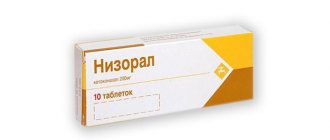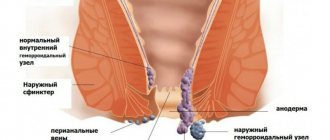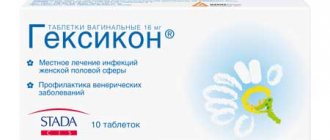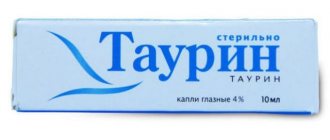Release form and composition
- Film-coated tablets: capsule-shaped, white or almost white, with a score on one side (6 or 10 pieces in aluminum foil strips, 1 strip in a cardboard box);
- Eye and ear drops 0.3%: transparent, colorless or slightly yellow solution, free from any particles (5 ml in dark glass bottles complete with a dropper cap or polyethylene dropper bottles, 1 bottle in a cardboard box).
Active ingredient: norfloxacin:
- 1 tablet – 400 mg;
- 1 ml drops – 3 mg.
Auxiliary components:
- Tablets: purified talc, magnesium stearate, colloidal silicon dioxide, sodium starch glycolate, sodium lauryl sulfate, titanium dioxide, microcrystalline cellulose, hydroxypropyl methylcellulose;
- Eye and ear drops: glacial acetic acid, sodium chloride, disodium edetate, benzalkonium chloride, injection water.
Indications for use
Normax is a drug for the treatment of infectious and inflammatory diseases caused by microorganisms sensitive to norfloxacin.
For tablets:
- Intestinal infections;
- Infections of the pelvic organs (including adnexitis and prostatitis);
- Urinary tract diseases;
- Gonococcal infection;
- Ophthalmic infections;
- Skin and soft tissue infections;
- Infections of the pharynx and larynx, paranasal sinuses, middle ear;
- Traveler's diarrhea;
- Prevention of sepsis in patients with neutropenia.
For eye and ear drops:
- Blepharitis;
- Keratitis;
- Conjunctivitis (including gonococcal);
- Keratoconjunctivitis;
- Blepharoconjunctivitis;
- Internal otitis;
- Acute and chronic otitis media;
- Otitis externa;
- Infectious eustachitis;
- Trachoma;
- Corneal ulcer.
In the form of eye and ear drops, Normax is also used for preventive purposes:
- Prevention of infectious otitis when removing a foreign body from the external auditory canal, accompanied by damage to ear tissue, with ear injuries, before and after surgical interventions;
- Prevention of infections after damage by physical or chemical means, removal of a foreign body from the conjunctiva or cornea, before and after surgery.
NORMAX
Drug: NORMAX Active substance: norfloxacin ATC code: J01MA06 KFG: Antibacterial drug of the fluoroquinolone group Reg. number: P No. 013963/01-2002 Registration date: 07.18.08 Owner reg. credential: IPCA LABORATORIES Ltd. {India}
DOSAGE FORM, COMPOSITION AND PACKAGING
| Film-coated tablets | 1 tab. |
| norfloxacin | 400 mg |
Excipients: microcrystalline cellulose, purified talc, sodium starch glycolate, colloidal silicon dioxide, sodium lauryl sulfate, magnesium stearate, hydroxypropyl methylcellulose, titanium dioxide.
6 pcs. — strips (1) — cardboard packs.
DESCRIPTION OF THE ACTIVE SUBSTANCE. The scientific information provided is general and cannot be used to make a decision about the possibility of using a particular drug.
PHARMACHOLOGIC EFFECT
Antimicrobial synthetic agent of the fluoroquinolone group with a broad spectrum of action. Has a bactericidal effect. By suppressing DNA gyrase, it disrupts the process of DNA supercoiling.
Highly active against most gram-negative bacteria: Escherichia coli, Salmonella spp., Shigella spp., Proteus spp., Morganella morganii, Klebsiella spp. (including Klebsiella pneumoniae), Enterobacter spp., Serratia spp., Citrobacter spp., Yersinia spp., Providencia spp., Haemophilus influenzae, Pseudomonas aeruginosa, Neisseria gonorrhoeae, Neisseria meningitidis.
Active against some gram-positive bacteria (including Staphylococcus aureus).
Anaerobic bacteria are resistant to norfloxacin; Enterococcus spp. are insensitive. and Acinetobacter spp.
Resistant to β-lactamase.
PHARMACOKINETICS
When taken orally, about 30-40% is absorbed; food intake reduces the rate of absorption. Plasma protein binding is 14%. Norfloxacin is well distributed in the tissues of the urogenital system. Penetrates through the placental barrier. About 30% is excreted unchanged in the urine.
INDICATIONS
Infectious and inflammatory diseases caused by microorganisms sensitive to norfloxacin.
For oral administration: diseases of the urinary tract, prostate gland, gastrointestinal tract, gonorrhea, prevention of relapses of urinary tract infections, bacterial infections in patients with granulocytopenia, “travelers' diarrhea”.
For topical use: conjunctivitis, keratitis, keratoconjunctivitis, corneal ulcers, blepharitis, blepharoconjunctivitis, acute inflammation of the meibomian glands and dacryocystitis, prevention of eye infections after removal of a foreign body from the cornea or conjunctiva, after damage by chemical agents, before and after eye surgery; external otitis, acute otitis media, chronic otitis media, prevention of infectious complications during surgical interventions on the organ of hearing.
DOSING REGIME
Individual. A single dose when taken orally is 400-800 mg, the frequency of use is 1-2 times a day. The duration of treatment is determined individually.
In ophthalmology and ENT practice it is used locally.
SIDE EFFECT
From the digestive system: nausea, heartburn, anorexia, diarrhea, abdominal pain.
From the side of the central nervous system: headache, dizziness, feeling of fatigue, sleep disorders, irritability, anxiety.
Allergic reactions: skin rash, itching, Quincke's edema.
From the urinary system: interstitial nephritis.
CONTRAINDICATIONS
Pregnancy, lactation (breastfeeding), childhood and adolescence (up to 15 years), deficiency of glucose-6-phosphate dehydrogenase, hypersensitivity to norfloxacin and other quinolone drugs.
PREGNANCY AND LACTATION
Norfloxacin is contraindicated during pregnancy and lactation (breastfeeding), since experimental studies have shown that it causes arthropathy.
SPECIAL INSTRUCTIONS
It should be used with caution in patients with epilepsy, convulsive syndrome of other etiologies, with severe impairment of renal and liver function. During the treatment period, patients should receive a sufficient amount of fluid (under the control of diuresis).
Norfloxacin should be taken at least 2 hours before or 2 hours after taking antacids or medications containing iron, zinc, magnesium, calcium or sucralfate.
DRUG INTERACTIONS
With simultaneous use of norfloxacin with warfarin, the anticoagulant effect of the latter is enhanced.
With simultaneous use of norfloxacin with cyclosporine, an increase in the concentration of the latter in the blood plasma is observed.
When taking norfloxacin simultaneously and antacids or drugs containing iron, zinc, magnesium, calcium or sucralfate, the absorption of norfloxacin is reduced due to the formation of complexons with metal ions (the interval between their administration should be at least 4 hours).
When administered concomitantly, norfloxacin reduces the clearance of theophylline by 25%; therefore, the dose of theophylline should be reduced when used concomitantly.
The simultaneous administration of norfloxacin with drugs that have the potential to lower blood pressure can cause a sharp decrease in blood pressure. In this regard, in such cases, as well as with the simultaneous administration of barbiturates and anesthetics, heart rate, blood pressure, and ECG indicators should be monitored. Concomitant use with drugs that lower the epileptic threshold can lead to the development of epileptiform seizures.
Reduces the effect of nitrofurans.
Directions for use and dosage
Film-coated tablets
In tablet form, Normax should be taken orally on an empty stomach (at least 1 hour before meals or 2 hours after meals), with a sufficient amount of water.
Recommended dosage regimens depending on indications:
- Acute uncomplicated cystitis: 200-400 mg 2 times a day for 3-5 days;
- Acute urinary tract infections: 400 mg 2 times a day for a 7-10-day course;
- Recurrent and chronic recurrent urinary tract infections: 400 mg 2 times a day for 4 weeks and in case of relapse - 400 mg per day for up to 12 weeks;
- Infections of the digestive system: 400 mg 2 times a day for 3-5 days;
- Acute uncomplicated gonococcal infection: once 800 mg;
- Infections of the genital organs: 400-600 mg 2 times a day for a 7-day course;
- Prevention of bacterial diarrhea: 400 mg 1 time per day;
- Prevention of sepsis in patients with neutropenia: 400 mg 3 times a day for 8 weeks;
- Other indications: 400 mg 2 times a day, for severe infections - 800 mg, for a course of at least 3 days.
For patients with renal failure and creatinine clearance of 10-30 ml/minute, the dose is reduced to 400 mg once a day.
Eye and ear drops
In the form of drops, the drug is applied topically.
Ophthalmic infections:
- Acute infectious eye diseases: at the beginning of treatment - 1-2 drops every 15-30 minutes, then reduce the frequency of instillations;
- Moderate eye infections: 1-2 drops 2 to 6 times a day;
- Acute and chronic trachoma: 2 drops in each eye 2-4 times a day for a course of 1-2 months, longer treatment is possible.
For ear diseases, use 5 drops in the ear 3 times a day; the external auditory canal should first be sanitized. Before instillation, the drops must be warmed to body temperature. For ease of use of the drug, you need to lie on your side or tilt your head back. After instillation, the head should be kept in the same position for approximately 2 minutes. If necessary, a turunda can be placed in the external auditory canal.
Normax is indicated for use until symptoms disappear and for another 48 hours.
Side effects
When using Normax in the form of drops:
- Digestive system: abdominal pain, diarrhea, heartburn, nausea, anorexia;
- Central nervous system: increased fatigue, irritability, sleep disorders, dizziness, anxiety, headache;
- Allergic reactions: skin rash, Quincke's edema, itching.
When using Normax in tablet form:
- Urinary system: interstitial nephritis;
- Gastrointestinal tract, liver: diarrhea, anorexia, nausea, transient increase in the activity of hepatic transaminases, lactate dehydrogenase and alkaline phosphatase;
- Central nervous system, psyche: vertigo, headache, tinnitus, irritability, anxiety, fatigue, confusion, drowsiness, hallucinations, fear, depression;
- Musculoskeletal system: in rare cases – tendon rupture, tendinitis;
- Laboratory indicators: leukopenia, eosinophilia, increased plasma creatinine concentration, decreased hematocrit;
- Allergic reactions: rarely - rash, urticaria, itching, anaphylactic shock.
Possible cases of overdose, interaction with other medications
If the drops are accidentally swallowed, the patient may experience the following symptoms: nausea, headache, vomiting, dizziness, diarrhea, anxiety. To eliminate such phenomena, symptomatic treatment is carried out. To do this, provide the victim with sufficient fluids and create an acidic urine reaction in order to prevent the development of crystalluria.
According to experts, a drug containing an active substance such as norfloxacin is incompatible with medications that have a pH value of 3-4 (that is, chemically or physically unstable).
special instructions
Pills
If simultaneous use of antacids or drugs containing magnesium, sucralfate, iron or zinc is necessary, at least 2-hour intervals should be observed between doses.
During treatment, it is necessary to ensure sufficient fluid intake into the human body (under the control of diuresis).
The likelihood of an increase in the prothrombin index should be taken into account.
When performing surgical operations, it is necessary to monitor the state of the blood coagulation system.
In case of pain in the tendons, as well as when the first signs of tenosynovitis appear, it is recommended to discontinue the drug.
During the treatment period, it is necessary to avoid exposure to direct sunlight, be careful when driving a car and performing potentially dangerous types of work that require increased concentration.
Ear and eye drops
In the form of drops, Normax is intended for topical use only. When instilling, to avoid contamination of the drug, care should be taken not to touch the tip of the pipette to any surfaces.
To achieve a better therapeutic effect, drops are recommended to be used simultaneously with systemic antimicrobial therapy (except for mild cases).
Within 30 minutes after instillation of the drug into the eyes, you should refrain from driving vehicles and performing potentially hazardous types of work.
general information
Normax –
eye/ear drops intended for the treatment of inflammatory diseases of the eyes and ears caused by microorganisms sensitive to the drug. Has a wide bactericidal spectrum of action (except for anaerobic bacteria). When applied topically in ophthalmology, it penetrates well into the tissues of the eye, which allows it to be used in the treatment of infectious diseases of the anterior segment of the eye (
and etc.).
Like most antibacterial eye drops, Normax can affect visual acuity immediately after use and reduce the rate of reactions. For this reason, it is not recommended to drive or perform other tasks that require high concentration and reaction speed while taking this medication.
Before starting a course of therapy, contact lenses should be removed and preferably not put back on until complete recovery. To avoid re-infection of the eye, it is recommended to dispose of old lenses and purchase new ones, which will be used after successful completion of the course of treatment.
Norfloxacin is incompatible with some other drugs. It is not used simultaneously with Cyclosporine, Warfarin, antacids and iron supplements.
Important! When administering eye drops, do not touch the tip of the bottle to the surface of the cornea or eyelids, face or hands to prevent infection of the drug. The bottle cannot be transferred to others; it is intended strictly for individual use. If the course of treatment was completed before the drug in the vial ran out, the remains should be thrown away; they are not stored for more than thirty days. Store eye drops in a cool, dark place, but not in the refrigerator.
We suggest you read: Why does the eye hurt when blinking?
If you are individually intolerant to the components of these eye drops or if for some reason they are not available, it is easy to find analogues. The following drugs have proven themselves to be effective alternatives:
- Phloxal. This antibacterial drug is available in the form of drops or ointment for topical use. The main active ingredient is ofloxacin, an analogue of norfloxacin, also from the group of fluoroquinolones.
- Tobrex. These antibacterial eye drops with the active component tobramycin extremely rarely cause side effects, therefore they are the drug of choice in the treatment of eye diseases in children, pregnant and lactating women.
- Levomycetin. A classic antibacterial drug, the drops additionally contain chloramphenicol and the hormonal substance dexamethasone. Thanks to its multicomponent composition, the drug not only destroys pathogenic microflora, but also relieves symptoms of inflammation - pain, swelling, redness, burning and itching.











